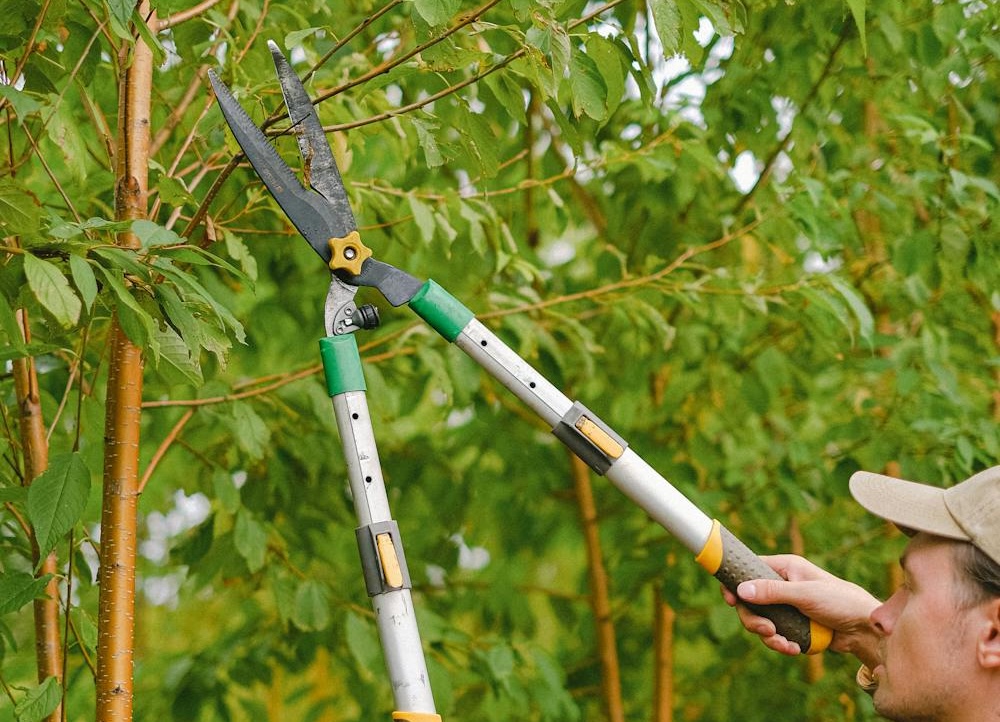Tree Pruning Best Practices: How Strategic Cuts Improve Growth, Prevent Rot, and Enhance Canopy HealthMarch 24, 2025 |
|
When you prune your trees strategically, you substantially improve their health, prevent the spread of diseases and rot, and enhance canopy health. Removing dead, diseased, or damaged branches stimulates healthy growth, improves air circulation and sunlight penetration, and reduces the risk of infections and pests. Techniques like crown thinning, deadwooding, and structural pruning help maintain a balanced tree structure and promote healthier foliage. Pruning at the right time, such as during the dormant season in winter, is essential, and making cuts just outside the branch collar guarantees proper healing. By following these best practices, you can keep your trees strong and resilient, and there’s more to learn about optimizing your tree care routine.  Tree Pruning Best Practices: How Strategic Cuts Improve Growth, Prevent Rot, and Enhance Canopy HealthWhen you prune your trees, strategic cuts are vital for improving growth, preventing rot, and enhancing canopy health. By removing dead, diseased, or crossing branches through techniques like crown thinning and deadwooding, you increase light penetration and airflow, reducing the risk of disease and promoting healthier foliage. Properly cutting just outside the branch collar guarantees fast healing and prevents damage to the tree, making it essential to understand and apply these best practices. Understanding Tree Pruning and Its Role in Tree HealthWhen you prune your trees strategically, you stimulate healthy growth by removing dead or damaged branches, allowing the tree to focus its energy on new development. This process improves the tree’s structure by enhancing air circulation and sunlight penetration, which in turn boosts the tree’s essentialness and helps it resist diseases. By pruning correctly, you prevent the spread of infections and pests, and you also eliminate weak or diseased branches that could compromise the tree’s health. Proper pruning techniques, such as making cuts just outside the branch collar, promote fast healing and prevent rot, ensuring the tree remains robust and resilient. Regular pruning also helps in maintaining a balanced framework, especially in young trees, reducing the risk of branch failure and enhancing the overall structural integrity of the tree. How pruning stimulates growth, improves structure, and prevents diseasePruning your trees is a critical maintenance procedure that stimulates growth, improves structure, and prevents disease. Through structural pruning, you remove dead, diseased, or damaged branches, which helps the tree focus its energy on healthier parts, stimulating new growth. This process also shapes the tree’s canopy, allowing more light to reach the leaves and reducing the risk of disease by removing infected areas. Key Pruning Techniques for Canopy Health and Growth ManagementWhen managing your tree’s canopy, you should focus on techniques like crown thinning, deadwooding, and structural pruning. Crown thinning involves selectively removing smaller branches to enhance light penetration and air circulation, reducing the risk of disease and pests. Deadwooding, on the other hand, is vital for removing dead, diseased, or damaged branches, which helps in preventing the spread of infection and maintaining the tree’s structural integrity. Structural pruning shapes the tree by removing poorly grown branches and those with weak structural strength, ensuring a balanced and healthy tree shape. Crown thinning, deadwooding, and structural pruning methods explainedCrown thinning, a selective pruning technique, involves the strategic removal of specific branches to enhance the health, structure, and aesthetic appeal of a tree. It improves light penetration, air movement, and wind resistance by removing overcrowded or weak branches. Deadwooding, another vital method, removes dead, diseased, or infected branches to prevent disease spread and reduce hazards. Make branch collar cuts to promote healing and prevent rot. Structural pruning focuses on developing a strong, stable tree structure by managing weight distribution and guiding future growth. Seasonal Timing: When and How to Prune for Best ResultsWhen deciding the best time to prune your trees, consider the seasonal impacts on their essential health. Winter is ideal for structural pruning, as trees are dormant, making it easier to see the branch structure and promoting proper wound closure before the spring growth spurt. In contrast, spring and summer pruning can stimulate new growth, which may not be desirable before the tree enters dormancy, while fall pruning can disrupt the tree’s preparation for dormancy and increase the risk of disease. The impact of winter, spring, summer, and fall pruning on tree vitalityPruning your trees at the right time of year can substantially affect their essential nature and overall health. Winter dormant pruning is ideal, as it reduces stress on the tree and promotes robust spring growth, enhancing canopy health. Following ANSI A300 pruning standards during this time helps in disease management and structural integrity. In spring, prune only what is necessary to avoid reducing bloom potential. Summer pruning controls overgrowth, while fall pruning is generally avoided to prevent susceptibility to diseases. Common Pruning Mistakes and Best Practices for Long-Term Tree CareWhen pruning your trees, it’s vital to avoid common mistakes that can compromise their health and structural integrity. Over-pruning, for instance, weakens trees and shortens their lifespan, while improper cuts like stub cutting and flush cutting can lead to infections and decay. Timing your pruning according to the specific needs of your tree species, such as pruning fruit trees in late winter or spring-flowering trees after blooming, is also essential for ideal results. Avoiding over-pruning, improper cuts, and timing errors for species-specific needsTo maintain the health and structural integrity of your trees, it is crucial to avoid over-pruning, make proper cuts, and prune at the right time, especially considering the specific needs of different tree species.
Consult a certified arborist to guarantee you’re using the best pruning techniques. |